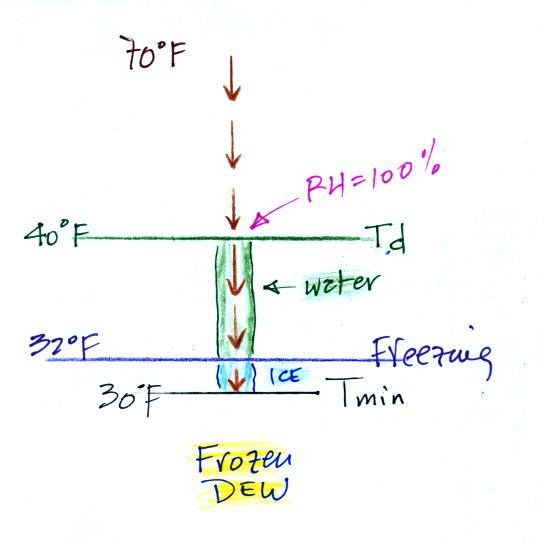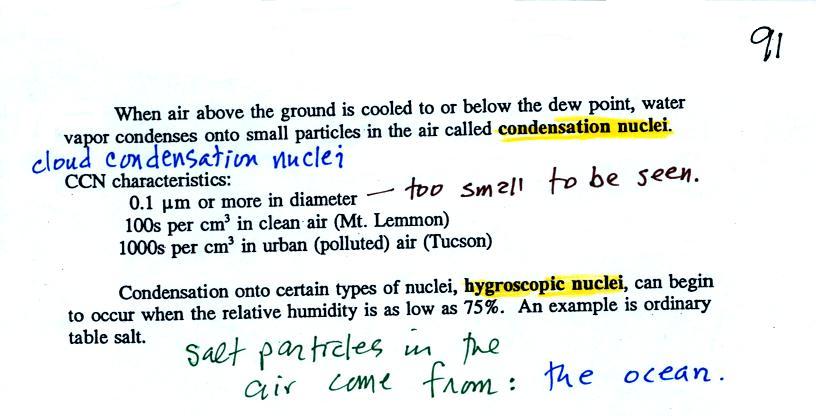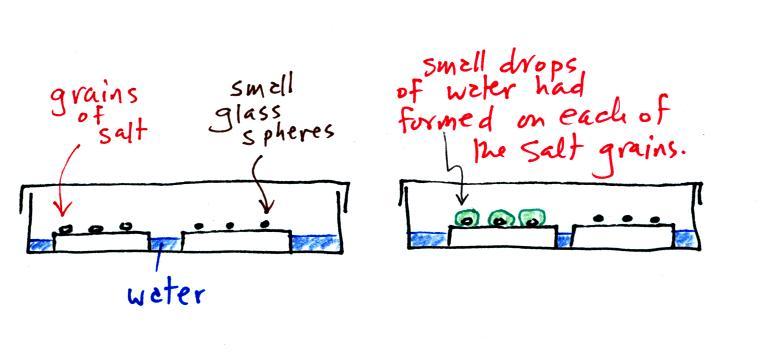
A variety of things can happen when you
cool air to the dew point and the relative humidity increases
to 100%. Point 1 shows that when moist air
next to the ground is cooled to and below the dew point, water
vapor condenses onto (or is deposited onto) the ground or
objects on the ground. This forms dew, frozen dew, and
frost.
Air above the ground can also be cooled to the dew point. When that happens (Point 2 above) it is much easier for water vapor to condense onto something rather than just forming a small droplet of pure water. In air above the ground water vapor condenses onto small particles in the air called condensation nuclei. Both the condensation nuclei and the small water droplets that form on them are usually too small to be seen with the naked eye. We can tell they are present (Point 3) because they scatter sunlight and make the sky hazy. As humidity increases dry haze turns to wet haze and eventually to fog (Point 4). And we'll finish class by creating a cloud in a bottle. We'll look at the role that condensation nuclei play in this process. Do they help or hinder cloud formation?

Air above the ground can also be cooled to the dew point. When that happens (Point 2 above) it is much easier for water vapor to condense onto something rather than just forming a small droplet of pure water. In air above the ground water vapor condenses onto small particles in the air called condensation nuclei. Both the condensation nuclei and the small water droplets that form on them are usually too small to be seen with the naked eye. We can tell they are present (Point 3) because they scatter sunlight and make the sky hazy. As humidity increases dry haze turns to wet haze and eventually to fog (Point 4). And we'll finish class by creating a cloud in a bottle. We'll look at the role that condensation nuclei play in this process. Do they help or hinder cloud formation?

This figure illustrates the formation of
dew. We start at the top and assume the temperature is
70 F at the end of the day. The temperature will start
to drop as we move from day to night. We assume the dew
point temperature is 40 F on this night (it is considerably
lower than that at the present time in Tucson, the air is very
dry). The relative humidity (RH) reaches 100% when the
air temperature has cooled to the dew point. The air
temperature continues to drop to a low of 35 F. When the
air is cooled below the dew point, the air finds itself with
more water vapor than it can contain. The excess
condenses and things on the ground get wet with dew.


Conditions are similar in this example
except for the nighttime temperature which is below
freezing. Dew would begin to form once the air
temperature reached the dew point. But once the air
temperature dropped below freezing the dew would
freeze. This isn't frost, rather frozen
dew. Frozen dew is often thicker and harder to
scrape off your car windshield than frost.


Now the dew point and the nighttime
minimum temperature are both below freezing.
When the air temperature reaches the dew point and the
RH reaches 100%, water vapor turns directly to ice (deposition).
This is frost.


What would happen here? In one case
both the air temperature and the dew point are above
freezing. They're both below freezing in the other
case. You'll find the answer at the end of today's
notes.

A short homemade video (my first actually) that showed how water vapor would, over time, preferentially condense onto small grains of salt rather than small spheres of glass. The figure below wasn't shown in class.

The following figure is at the bottom of p. 91 in the ClassNotes.

This figure shows how cloud condensation nuclei and increasing relative humidity can affect the appearance of the sky and the visibility.
The air in the left most figure is relatively dry. Even though the condensation nuclei particles are too small to be seen with the human eye you can tell they are there because they scatter sunlight. When you look at the sky you see the deep blue color caused by scattering of sunlight by air molecules mixed together with some white sunlight scattered by the condensation nuclei. This changes the color of the sky from a deep blue to a bluish white color. The more particles there are the whiter the sky becomes. This is called "dry haze." Visibility under these conditions might be a few tens of miles.
The middle picture shows what happens when you drive from the dry southwestern part of the US into the humid southeastern US or the Gulf Coast. One of the first things you would notice is the hazier appearance of the air and a decrease in visibility. Because the relative humidity is high, water vapor begins to condense onto some of the condensation nuclei particles (the hygroscopic nuclei) in the air and forms small water droplets. The water droplets scatter more sunlight than just small particles alone. The increase in the amount of scattered light is what gives the air its hazier appearance. This is called "wet haze." Visibility now might now only be a few miles.
Finally when the relative humidity increases to 100% fog forms. Fog can cause a severe drop in the visibility. The thickest fog forms in dirty air that contains lots of condensation nuclei. That is part of the reason the Great London Smog of 1952 was so impressive. Visibility was at times just a few feet! We could see this effect in the cloud-in-a-bottle demonstration that was performed next.
Cooling air, changing relative humidity, condensation nuclei, and scattering of light are all involved in this demonstration.

We used my backup flask in class. Normally I use use a strong, thick-walled, 4 liter vacuum flask (designed to not implode when all of the air is pumped out of them, they aren't designed to not explode when pressurized). There was a little water in the bottom of the flask to moisten the air in the flask. Next we pressurized the air in the flask with a bicycle pump. At some point the pressure blows the cork out of the top of the flask. The air in the flask expands outward and cools. This sudden cooling increases the relative humidity of the moist air in the flask to 100% ( probably more than 100% momentarily ) and water vapor condenses onto cloud condensation nuclei in the air. A very faint cloud became visible at this point.

The demonstration was repeated an additional time with one small change. A burning match was dropped into the bottle. The smoke from the matches added lots of very small particles, condensation nuclei, to the air in the flask. The same amount of water vapor was available for cloud formation but the cloud that formed this time was quite a bit "thicker" and much easier to see. To be honest the burning match probably also added a little water vapor (water vapor together with carbon dioxide is one of the by products of combustion).
This effect has some implications for climate change.

A cloud that forms in dirty air is composed of a large
number of small droplets (right figure above). This
cloud is more reflective than a cloud that forms in clean
air, that is composed of a smaller number of larger
droplets (left figure).
Combustion of fossil fuels adds carbon dioxide to the atmosphere. There is concern that increasing carbon dioxide concentrations (and other greenhouse gases) will enhance the greenhouse effect and cause global warming. Combustion also adds condensation nuclei to the atmosphere (just like the burning match added smoke to the air in the flask). More condensation nuclei might make it easier for clouds to form, might make the clouds more reflective, and might cause cooling. There is still quite a bit of uncertainty about how clouds might change and how this might affect climate. Remember that clouds are good absorbers of IR radiation and also emit IR radiation.
Clouds are one of the best ways of cleaning the atmosphere

A cloud is composed of small water droplets (diameters of 10 or 20 micrometers) that form on particles ( diameters of perhaps 0.1 or 0.2 micrometers). The droplets "clump" together to form a raindrop (diameters of 1000 or 2000 micrometers which is 1 or 2 millimeters), and the raindrop carries the particles to the ground. A typical raindrop can contain 1 million cloud droplets so a single raindrop can remove a lot of particles from the air. You may have noticed how clear the air seems the day after a rainstorm; distant mountains are crystal clear and the sky has a deep blue color. Gaseous pollutants can dissolve in the water droplets and be carried to the ground by rainfall also. We'll be looking at the formation of precipitation later this week.
When the relative humidity
in air above the ground (and away from objects on the
ground) reaches 100%, water vapor will condense onto small
particles called condensation nuclei. It would be much
harder for the water vapor to just condense and form small
droplets of pure water (you can learn why that is so by
reading the top of p. 92
in the photocopied class notes). There are always lots
of CCN (cloud condensation nuclei in the air) so this isn't
an impediment to cloud formation.

Water vapor will condense
onto certain kinds of condensation nuclei even when the
relative humidity is below 100% (again you will find some
explanation of this on the bottom of p. 92).
These are called hygroscopic nuclei. Salt
is an example; small particles of salt mostly come from
evaporating drops of ocean water.
A short homemade video (my first actually) that showed how water vapor would, over time, preferentially condense onto small grains of salt rather than small spheres of glass. The figure below wasn't shown in class.

The start of the video at
left showed the small grains of salt were placed on a
platform in a petri dish containing water. Some small
spheres of glass were placed in the same dish. After
about 1 hour small drops of water had formed around each of
the grains of salt but not the glass grains (shown above at
right).
In humid parts of the US, water will condense onto the grains of salt in a salt shaker causing them to stick together. Grains of rice apparently absorb moisture which keeps this from happening and also break up lumps of salt once they start to form. Grains of rice might also be used because they won't fall out of the holes in the salt shaker together with the salt. You'll find this discussed in an interesting Wikipedia article about salt.
In humid parts of the US, water will condense onto the grains of salt in a salt shaker causing them to stick together. Grains of rice apparently absorb moisture which keeps this from happening and also break up lumps of salt once they start to form. Grains of rice might also be used because they won't fall out of the holes in the salt shaker together with the salt. You'll find this discussed in an interesting Wikipedia article about salt.
The following figure is at the bottom of p. 91 in the ClassNotes.

This figure shows how cloud condensation nuclei and increasing relative humidity can affect the appearance of the sky and the visibility.
The air in the left most figure is relatively dry. Even though the condensation nuclei particles are too small to be seen with the human eye you can tell they are there because they scatter sunlight. When you look at the sky you see the deep blue color caused by scattering of sunlight by air molecules mixed together with some white sunlight scattered by the condensation nuclei. This changes the color of the sky from a deep blue to a bluish white color. The more particles there are the whiter the sky becomes. This is called "dry haze." Visibility under these conditions might be a few tens of miles.
The middle picture shows what happens when you drive from the dry southwestern part of the US into the humid southeastern US or the Gulf Coast. One of the first things you would notice is the hazier appearance of the air and a decrease in visibility. Because the relative humidity is high, water vapor begins to condense onto some of the condensation nuclei particles (the hygroscopic nuclei) in the air and forms small water droplets. The water droplets scatter more sunlight than just small particles alone. The increase in the amount of scattered light is what gives the air its hazier appearance. This is called "wet haze." Visibility now might now only be a few miles.
Finally when the relative humidity increases to 100% fog forms. Fog can cause a severe drop in the visibility. The thickest fog forms in dirty air that contains lots of condensation nuclei. That is part of the reason the Great London Smog of 1952 was so impressive. Visibility was at times just a few feet! We could see this effect in the cloud-in-a-bottle demonstration that was performed next.
Cooling air, changing relative humidity, condensation nuclei, and scattering of light are all involved in this demonstration.

We used my backup flask in class. Normally I use use a strong, thick-walled, 4 liter vacuum flask (designed to not implode when all of the air is pumped out of them, they aren't designed to not explode when pressurized). There was a little water in the bottom of the flask to moisten the air in the flask. Next we pressurized the air in the flask with a bicycle pump. At some point the pressure blows the cork out of the top of the flask. The air in the flask expands outward and cools. This sudden cooling increases the relative humidity of the moist air in the flask to 100% ( probably more than 100% momentarily ) and water vapor condenses onto cloud condensation nuclei in the air. A very faint cloud became visible at this point.

The demonstration was repeated an additional time with one small change. A burning match was dropped into the bottle. The smoke from the matches added lots of very small particles, condensation nuclei, to the air in the flask. The same amount of water vapor was available for cloud formation but the cloud that formed this time was quite a bit "thicker" and much easier to see. To be honest the burning match probably also added a little water vapor (water vapor together with carbon dioxide is one of the by products of combustion).
This effect has some implications for climate change.

Combustion of fossil fuels adds carbon dioxide to the atmosphere. There is concern that increasing carbon dioxide concentrations (and other greenhouse gases) will enhance the greenhouse effect and cause global warming. Combustion also adds condensation nuclei to the atmosphere (just like the burning match added smoke to the air in the flask). More condensation nuclei might make it easier for clouds to form, might make the clouds more reflective, and might cause cooling. There is still quite a bit of uncertainty about how clouds might change and how this might affect climate. Remember that clouds are good absorbers of IR radiation and also emit IR radiation.
Clouds are one of the best ways of cleaning the atmosphere

A cloud is composed of small water droplets (diameters of 10 or 20 micrometers) that form on particles ( diameters of perhaps 0.1 or 0.2 micrometers). The droplets "clump" together to form a raindrop (diameters of 1000 or 2000 micrometers which is 1 or 2 millimeters), and the raindrop carries the particles to the ground. A typical raindrop can contain 1 million cloud droplets so a single raindrop can remove a lot of particles from the air. You may have noticed how clear the air seems the day after a rainstorm; distant mountains are crystal clear and the sky has a deep blue color. Gaseous pollutants can dissolve in the water droplets and be carried to the ground by rainfall also. We'll be looking at the formation of precipitation later this week.
Here's a summary of the dew, frozen dew,
and frost material earlier in the notes.


Note in the first 3 cases the nighttime
minimum temperature (Tmin) drops below the dew point
temperature (Td). Nothing forms in the last case
because Tmin never cools to the dew point and the relative
humidity never reaches 100%.
Nothing would form in the two situations drawn earlier in the notes. In the first case Tmin = 40 F and Td = 35 F and in the second case Tmin = 30 F and Td = 25 F. The RH would never reach 100% in either of those situations.
Currently in Tucson nighttime minimum temperatures are dropping into the upper 40s perhaps the low 50s. Dew points meanwhile are much lower, perhaps 10 F. The nighttime minimum temperature isn't getting anywhere close to the dew point and the ground is remaining dry overnight.
Nothing would form in the two situations drawn earlier in the notes. In the first case Tmin = 40 F and Td = 35 F and in the second case Tmin = 30 F and Td = 25 F. The RH would never reach 100% in either of those situations.
Currently in Tucson nighttime minimum temperatures are dropping into the upper 40s perhaps the low 50s. Dew points meanwhile are much lower, perhaps 10 F. The nighttime minimum temperature isn't getting anywhere close to the dew point and the ground is remaining dry overnight.